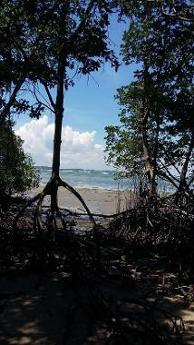Natural Climate Protection in Marine and Coastal Ecosystems
Seas hold an immense importance for humans, nature and climate protection. Carbon is absorbed both by water and the living organisms’ biomass as well as the oceanic sediment. It is partly stored over the long term before being released back into the environment. Marine and coastal ecosystems are essential in maintaining the climate’s stability. However, they are endangered by the consequences of climate change and direct human interventions.
Natural climate protection in marine and coastal ecosystems is summarised under the keyword ‘blue carbon’. This includes ecosystems such as mangrove forests, seagrass meadows and salt marshes, which store carbon in their biomass and in the sediments and thus contribute to natural climate protection. In addition, they provide protection against extreme events such as storms and floods, which is particularly vital for people living in coastal regions in view of the consequences of global warming. Other positive effects for sustainable development are preservation and promotion of biodiversity, food provision and socio-cultural ecosystem services.
Marine climate protection also includes technical processes for carbon sequestration (for example artificial upwelling to change ocean currents) and processes in which individual natural processes are used, but without modifying a natural ecosystem as a whole, as is the case with nature-based solutions (NbS) (for example alkalinisation of the ocean). These interventions are not presented in more detail on this site, but on our geoengineering thematic sites.
To the topic
UBA: Permitting research projects on marine geoengineering
Potential of ‘Blue Carbon‘
Coastal ecosystems can contribute to the long-term carbon sequestration. The three ecosystems of mangroves, seagrass meadows and salt marshes alone store over 80 million tonnes of carbon every year. For example, mangroves and their sediments store three to five times and seagrass meadows up to twice as much CO2 per hectare per year as terrestrial forests. This shows the enormous potential of coastal ecosystems in the fight against climate change. However, carbon only remains bound in the sediment as long as the ecosystem remains undisturbed.

Due to climate change and anthropogenic activities, coastal ecosystems are under increasing pressure and are now among the areas with the highest annual rates of land loss. Warming and acidification of the ocean, sea-level rise, loss of oxygen, storms and storm surges are among the direct consequences of man-made climate change and endanger marine ecosystems. In addition, there are further anthropogenic impacts from agriculture, fishing, raw material extraction and coastal development. As a result, carbon stored in the sediment is released and the CO2 sink increasingly becomes an emissions source.
As the new 6th Assessment Report of the Intergovernmental Panel on Climate Change (IPCC) requires, it is essential to protect and restore ecosystems to maintain and enhance nature's capacity to absorb and store carbon. This can counteract global warming and promote a climate-resilient development. Synergies between climate, environmental and biodiversity protection can be used and conflicts between adaptation and mitigation can be overcome.
The long-term natural storage of atmospheric CO2 in blue carbon ecosystems can contribute to achieving the goal of climate neutrality set out in the Paris Agreement. However, the possibility of sequestration must not be used as a legitimisation to postpone technically and socially possible emission reduction efforts. Moreover, the potential for CO2 storage in marine ecosystems is not unlimited.
Adequate funding and political support through appropriate frameworks are needed in order to exploit the potential of blue carbon ecosystems in an environmentally-integer and science-based way.


